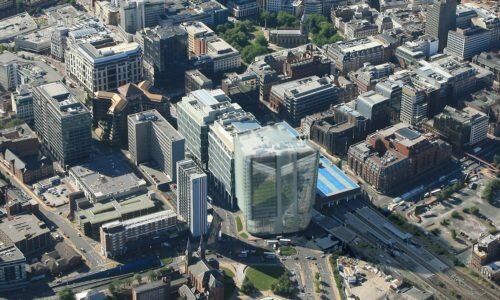
Birmingham’s urban renaissance continues – but planning reforms needed
A new report reveals the extent of urban transformation in Birmingham in recent decades – showing that the number of people living and working in the city centre has soared compared to most other cities. However, the report warns that planning reforms are needed to enable cities to provide both the commercial space as well as housing required, reports Kevin Johnson.
The report, published today by think tank and sponsored by international law firm DAC Beachcroft, examines the challenges British cities face in managing competing demands for residential and commercial space – especially in their city centres, where high skilled, high paying businesses increasingly choose to locate.
, including some controlled development of green belt land. The boss of Centre for Cities says that Birmingham’s local leaders need to take tough decisions on how to sustain the growth of the commercial centre, while also providing the homes that people in Birmingham need.
It shows that the cities which have seen the biggest growth in their city centres over recent decades are not those with long-established successful economies (which are largely in the South East), but instead the major urban centres of the North and Midlands, which until recently had struggled to shake off their post-industrial hangovers.
Birmingham has seen the third highest city centre growth in England in recent decades (as measured by combined jobs and residential growth in central areas).
For those who enjoy comparing Birmingham’s performance with the other core cities, especially the one beginning with M, may be disappointed to learn that the so called ‘Second City’ comes in behind Manchester and Leeds.
Top 10 cities in England and Wales – biggest growth in city centre population and jobs
Population growth in city centre (2002-2015)
Jobs growth in city centre (1998-2015)
1 Manchester 149% 84%
2 Leeds 151% 34%
3 Birmingham 162% 30%
4 Liverpool 181% 27%
5 Milton Keynes 110% 52%
6 Bristol 86% 41%
7 Newcastle 112% 29%
8 Cardiff 86% 19%
9 Brighton 38% 31%
10 Norwich 57% 16%
20 London 22% 71%
City centre average across England & Wales
47% 34%
The city centre population of Birmingham grew more than seven times faster than that of London’s between 2002 and 2015.
Birmingham also saw a 30% rise in employment in its city centre between 1998 and 2015 – an increase of around 30,600 jobs in total.
However, the report also warns that the urban resurgence in places like Birmingham – and the continued growth of other successful cities – could be undermined by planning polices which prioritise residential development over commercial space in city centres.
In particular, it argues that Permitted Development Rights (which allow commercial space to be converted for residential use without planning permission) are threatening the commercial property which is integral to attracting firms and jobs to city centres.
The report makes two key recommendations to ensure that cities can protect and strengthen their commercial centres, while also building the houses they need:
- The Government should allow cities to exclude their centres from Permitted Development Rights. This would enable cities to stop the ad hoc conversion of city centre commercial space into residential property. It would therefore give cities more scope to protect their commercial centres, and to ensure they have the office space required to attract more businesses and jobs in future.
- Cities should relax planning laws in other parts of cities to allow more house building. Alongside measures to promote strong city centres, cities should consider how they can free up more land for house building in other areas. In particular, allowing some controlled development of green belt land will be crucial for successful cities to address their housing needs, without undermining their commercial centres.
Commenting on the report’s findings, Andrew Carter, Chief Executive of Centre for Cities, said:
Thirty years ago the centre of Birmingham was run-down and struggling, but since then it has undergone a dramatic transformation, becoming an increasingly attractive location for people to live and work in.
This urban renaissance has brought opportunities for people living across the city and its surrounding areas, and it’s vital that it continues. But for that to happen, local leaders need to take tough decisions on how to sustain the growth of the commercial centre, while also providing the homes that people in Birmingham need.
Public debate on these questions has rightly focused on housing issues. But addressing these problems shouldn’t come at the expense of city centre commercial space, which will be vital in bringing more businesses, jobs and opportunities to Birmingham in the future.
Reforming planning laws to protect the commercial heart of the city – and to encourage more house-building in other areas – will help Birmingham to manage these competing demands, and to continue to prosper in future.
Christopher Stanwell, Head of Planning at DAC Beachcroft, said:
The report captures the essence of competing dynamics in our city centres. Solutions lie in sophisticated, collaborative responses that recognise the different patterns of use in different cities and that not all green belt is equal. Variable situations require flexible approaches.
The report’s data is from the Office for National Statistics, Small Area Population Estimates and Business Structure Database.
Similar Articles
Council: Panel stands down, but recommends another one pop up
The Panel set up to oversee improvements to Birmingham city council has disbanded itself and
Brexit Watch: The List
We are living though extraordinary political times. The only thing to do in such circumstances
Birmingham City Council – a beacon (yes, you read that correctly)
They’re a tricky business, industrial relations, and I normally steer well clear. However, when the
Region needs more jobs, higher skills and better housing – report
A new report into economic injustice in Birmingham and the Black Country paints a stark
The ins, outs and whereabouts of fly-tipping
On the day Birmingham's latest bin strike starts up, Chris Game throws a political dead










